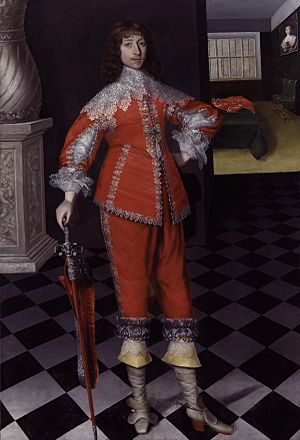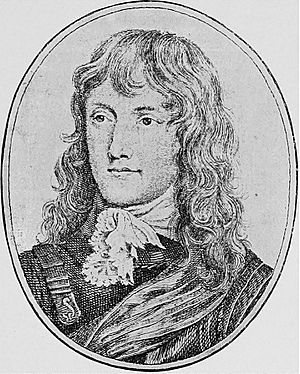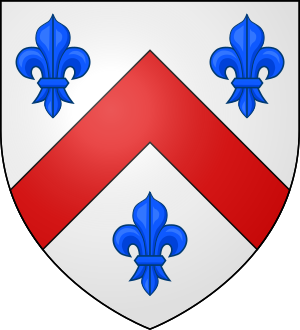John Belasyse, 1st Baron Belasyse facts for kids
Quick facts for kids
The Lord Belasyse
|
|
|---|---|

1st Baron Belasyse
Portrait by Gilbert Jackson, 1636 |
|
| First Lord of the Treasury | |
| In office 4 January 1687 – 9 April 1689 |
|
| Preceded by | Laurence Hyde, 1st Earl of Rochester (as Lord High Treasurer) |
| Succeeded by | Charles Mordaunt, 1st Earl of Monmouth |
| Personal details | |
| Born |
John Belasyse
24 June 1614 Newburgh Grange, Yorkshire |
| Died | 10 September 1689 (aged 75) Whitton, Middlesex |
| Resting place | St Giles in the Fields, London |
| Nationality | English |
John Belasyse, 1st Baron Belasyse (24 June 1614 – 10 September 1689) was an English nobleman and a loyal officer for the King during the English Civil War. He was also a Member of Parliament. He became famous for his actions during and after the Civil War. He was held in prison for a long time during a period called the Popish Plot, but he was never found guilty. From 1671 until he died, he lived in Whitton, near Twickenham.
Contents
Early Life and Family
John Belasyse was born at Newburgh Grange in Yorkshire. He was baptized on July 24, 1614. His father was Thomas Belasyse, 1st Viscount Fauconberg, who was also a Member of Parliament. His mother was Barbara Cholmondeley.
A Life of Service
Fighting in the Civil War
When the English Civil War began, John Belasyse supported King Charles I. He was removed from Parliament because of this. He used his own money to create six groups of soldiers, both horsemen and foot soldiers.
He fought in many important battles, including the Battle of Edgehill and the Battle of Brentford in 1642. He also fought in the First Battle of Newbury (1643) and the Battle of Naseby (1645). He was part of the attacks on cities like Reading, Bristol, and Newark. He was wounded several times during these fights.
Later, he became a top general for the King's forces in Northern England. He was also made Governor of York and Newark. In 1645, King Charles I made him a nobleman, giving him the title of Baron Belasyse of Worlaby.
Samuel Pepys, a famous diarist, wrote about an interesting event involving Lord Belasyse. The King sent a secret message to Belasyse, who was the governor of Newark. The message was written in code, wrapped in lead, and swallowed by the messenger! The messenger had to take medicine to get the message out. This message told Belasyse that the King would soon go to the Scottish army.
After the War
After the King returned to power, Lord Belasyse received several important jobs. He became the Lord-Lieutenant of the East Riding of Yorkshire (1660–1673) and the Governor of Kingston upon Hull (1661-1673). From 1665 to 1666, he was the Governor of Tangier, a city in Africa that was controlled by England at the time.
In 1672, he left his job as Captain of the Gentlemen-at-Arms. This was because he was a Catholic and refused to take a special oath required by a law called the Test Act.
The Popish Plot
During a time known as the plot of Titus Oates, Lord Belasyse and four other Catholic noblemen were accused of planning against the King. This was a false accusation. People claimed Belasyse was supposed to lead a "Popish army." However, King Charles II found this idea funny because Belasyse was an older man who had trouble standing due to illness.
Even though he was accused, Lord Belasyse was never put on trial. He was held in the Tower of London for a long time, but he was eventually released.
Serving King James II
When King James II became king, Lord Belasyse was again given important roles. In 1686, he became a Privy Counsellor, which meant he advised the King. In 1687, he was made the First Lord Commissioner of the Treasury. This caused some political issues because he was Catholic, but he was known for being a moderate person in the King's court.
Family Life
Lord Belasyse was married three times. He had at least sixteen children with his first and third wives, though many of them died when they were very young.
His first wife was Jane Boteler. They had a son named Henry Belasyse. Henry died before his father in a duel in 1667. This meant the title of Baron Belasyse later passed to Henry's son, Henry Belasyse, 2nd Baron Belasyse (who died without sons).
His second wife was Anne Crane. His third wife was Anne Paulet.
He had seven daughters who lived to adulthood:
- Isabel Belasyse, who married Thomas Stonor.
- Mary Belasyse, who married Robert Constable. Samuel Pepys noted that Mary loved music very much.
- Barbara Belasyse, who married Sir John Webbe.
- Honora Belasyse, who married George Nevill, 12th Baron Bergavenny.
- Catherine Belasyse, who married John Talbot.
- Anne Belasyse.
- Elizabeth Belasyse.
Later Years and Legacy
Lord Belasyse passed away on September 10, 1689. He was buried at the church of St Giles in the Fields in London. A monument was built to remember him, which described his loyalty and bravery. It mentioned his service in the Civil War, where he fought in many battles and was wounded. It also listed his important jobs after the war, like Governor of Hull and First Lord Commissioner of the Treasury.
Images for kids
-
Monument to Lord Belasyse in the old Church of St Giles in the Fields, London. This monument was later destroyed.




